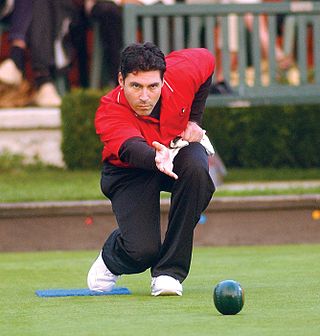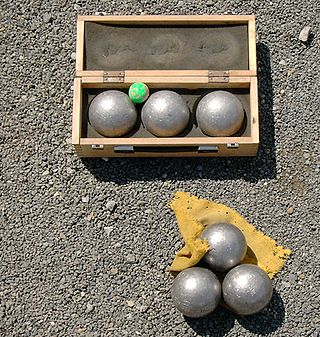Related Research Articles

Bowls, also known as lawn bowls or lawn bowling, is a sport in which the objective is to roll biased balls so that they stop close to a smaller ball called a "jack" or "kitty". It is played on a bowling green, which may be flat or convex or uneven. It is normally played outdoors and the outdoor surface is either natural grass, artificial turf or cotula.

Pétanque is a sport that falls into the category of boules sports, along with raffa, bocce, boule lyonnaise, lawn bowls, and crown green bowling. In all of these sports, players or teams play their boules/balls towards a target ball.

Boules is a collective name for a wide range of games similar to bowls and bocce in which the objective is to throw or roll heavy balls as closely as possible to a small target ball, called the jack in English.
Underarm bowling is a style of bowling in cricket. The style is as old as the sport itself. Until the introduction of the roundarm style in the first half of the 19th century, bowling was performed in the same way as in the sport of bowls, with the ball being delivered with the hand below the waist. Bowls may well be an older game than cricket and it is possible that it provided a template for delivering a ball with a degree of accuracy.

This is a general glossary of the terminology used in the sport of cricket. Where words in a sentence are also defined elsewhere in this article, they appear in italics. Certain aspects of cricket terminology are explained in more detail in cricket statistics and the naming of fielding positions is explained at fielding (cricket).

In cricket, an over consists of six legal deliveries bowled from one end of a cricket pitch to the player batting at the other end, almost always by a single bowler.

In cricket, a no-ball is a type of illegal delivery to a batter. It is also a type of extra, being the run awarded to the batting team as a consequence of the illegal delivery. For most cricket games, especially amateur, the definition of all forms of no-ball is from the MCC Laws of Cricket.

A bowling green is a finely laid, close-mown and rolled stretch of turf for playing the game of bowls.
Fast bowling is one of two main approaches to bowling in the sport of cricket, the other being spin bowling. Practitioners of pace bowling are usually known as fast bowlers, quicks, or pacemen. They can also be referred to as a seam bowler, a swing bowler or a fast bowler who can swing it to reflect the predominant characteristic of their deliveries. Strictly speaking, a pure swing bowler does not need to have a high degree of pace, though dedicated medium-pace swing bowlers are rarely seen at Test level in modern times.
This is a glossary of terms in curling.

A delivery or ball in cricket is a single action of bowling a cricket ball toward the batsman. Once the ball has been delivered, batsmen may attempt to score runs, with the bowler and other fielders attempting to stop this by getting the batsmen out. When the ball becomes dead, the next delivery can begin.

Lawn bowls at the 2005 Southeast Asian Games took place in the Hidden Vale Sports Club in Angeles City, Philippines.
These terms are used in contract bridge, using duplicate or rubber scoring. Some of them are also used in whist, bid whist, the obsolete game auction bridge, and other trick-taking games. This glossary supplements the Glossary of card game terms.
Short mat bowls is an indoor sport in which players attempt to score points by rolling a heavy ball along a fairly flat surface, to gain as many shots as possible by getting their bowls nearer to the jack than their opponents, and so outscore them. The game is a modern variation on lawn bowls, from which it is derived.
Carpet bowls is a variant of lawn bowls played indoors. Originating in England, it is played particularly in the South of England, although it is played at League and County level in East Anglia, the Midlands and the North. There are also a few players in Eastern Townships, Quebec, Canada. Despite the name, carpet bowls is not just a trivial indoor game played at home.

Southampton Old Bowling Green, situated on the corner of Lower Canal Walk and Platform Road, Southampton, England, is the world's oldest surviving bowling green. It was first used in 1299; Chesterfield Bowling Club in Derbyshire is believed to date back to 1294.
New Zealand Indoor Bowls (NZIB) is a form of Indoor bowls that is a highly competitive strategic sport. As its only international fixture is a Trans-Tasman event played under Trans-Tasman rules, it is a sport unique to New Zealand.

The Bowls Premier League (BPL) is a biannual bowls competition involving teams from around Australia. The competition was founded in 2013 as a way to popularise the sport by presenting in a modernised format, using the term "made-for-television" in its promotion. The competition features faster play, modified rules, colourful clothing and comprehensive television coverage.
Crown green bowls is a code of bowls played outdoors on a grass or artificial turf surface known as a bowling green. The sport's name is derived from the intentionally convex or uneven nature of the bowling green which is traditionally formed with a raised centre known as the crown.
References
- ↑ Munro, J.P. (1951). Bowls Encyclopedia. Melbourne Australia: Wilke & Co. p. 136.
- ↑ "Uses for Bentgrass Seed". seedland.com. Archived from the original on 3 May 2014. Retrieved 23 January 2014.
- ↑ Crystal-Mark (2010). Laws of the Sport of Bowls. World Bowls Ltd. p. 6.
- ↑ "Laws of the sport of bowls Crystal Mark second edition" (PDF). World Bowls Limited. Archived from the original (PDF) on 26 November 2013. Retrieved 24 January 2014.
- ↑ Crystal-Mark 2010, p. 26.
- ↑ "Laws of the sport of bowls Crystal Mark second edition including domestic regulations for Australia" (PDF). World Bowls Limited. Retrieved 24 January 2014.
- ↑ Crystal-Mark 2010, p. 18.
- ↑ Crystal-Mark 2010, p. 26 s23.1.3.
- ↑ "Lawn Bowling Turfgrasses". seedland.com. Retrieved 23 January 2014.